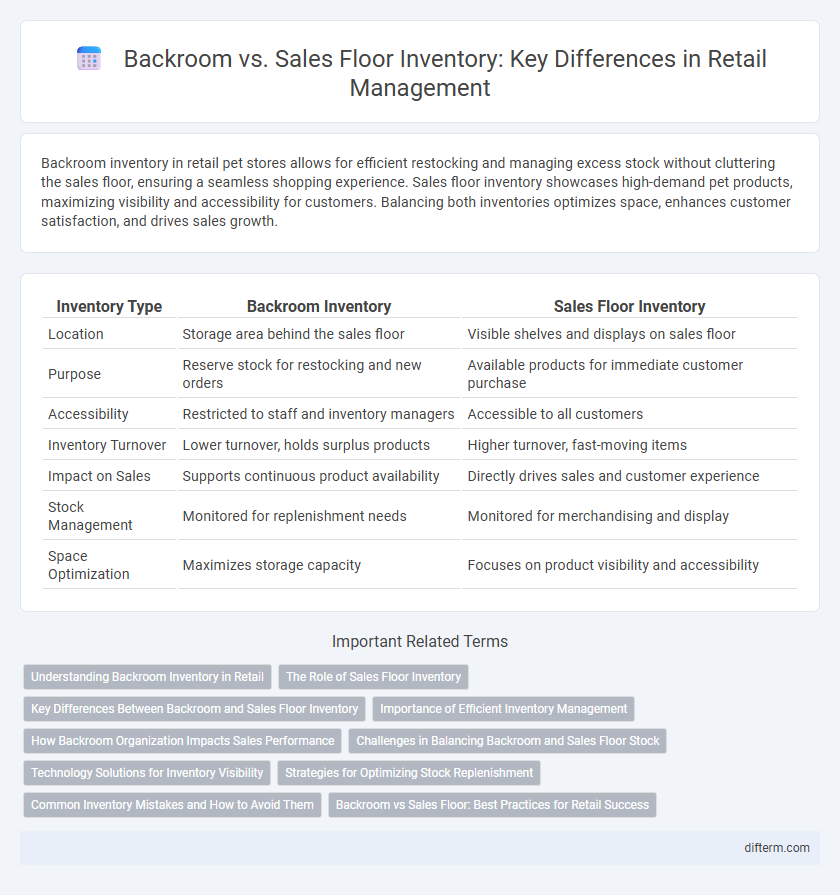Backroom inventory in retail pet stores allows for efficient restocking and managing excess stock without cluttering the sales floor, ensuring a seamless shopping experience. Sales floor inventory showcases high-demand pet products, maximizing visibility and accessibility for customers. Balancing both inventories optimizes space, enhances customer satisfaction, and drives sales growth.
Table of Comparison
| Inventory Type | Backroom Inventory | Sales Floor Inventory |
|---|---|---|
| Location | Storage area behind the sales floor | Visible shelves and displays on sales floor |
| Purpose | Reserve stock for restocking and new orders | Available products for immediate customer purchase |
| Accessibility | Restricted to staff and inventory managers | Accessible to all customers |
| Inventory Turnover | Lower turnover, holds surplus products | Higher turnover, fast-moving items |
| Impact on Sales | Supports continuous product availability | Directly drives sales and customer experience |
| Stock Management | Monitored for replenishment needs | Monitored for merchandising and display |
| Space Optimization | Maximizes storage capacity | Focuses on product visibility and accessibility |
Understanding Backroom Inventory in Retail
Backroom inventory in retail refers to the stock stored behind the scenes, separate from the sales floor, enabling quick replenishment and efficient inventory management. This inventory is crucial for maintaining product availability, reducing stockouts, and optimizing shelf space to enhance customer experience. Proper tracking and organization of backroom inventory directly impact turnover rates and operational efficiency in retail stores.
The Role of Sales Floor Inventory
Sales floor inventory plays a crucial role in enhancing customer experience by making products immediately accessible for purchase, driving impulse buys and increasing turnover rates. It serves as a real-time reflection of current demand trends, enabling staff to quickly identify popular items and adjust merchandising strategies accordingly. Efficient management of sales floor inventory reduces stockouts, supports accurate replenishment from backroom stock, and maximizes overall retail profitability.
Key Differences Between Backroom and Sales Floor Inventory
Backroom inventory refers to stock stored in a designated area away from customer view, ensuring backup supply for replenishing sales floor displays. Sales floor inventory consists of merchandise accessible and displayed for customers to browse and purchase directly, reflecting current demand trends. Key differences include visibility to customers, accessibility for restocking, and the role each plays in maintaining product availability and sales continuity.
Importance of Efficient Inventory Management
Efficient inventory management in retail balances backroom storage and sales floor stock to maximize product availability and minimize stockouts. Maintaining accurate inventory records ensures timely replenishment, reducing lost sales and enhancing customer satisfaction. Streamlined stock handling improves space utilization and operational costs, driving overall profitability.
How Backroom Organization Impacts Sales Performance
Efficient backroom organization directly enhances sales performance by ensuring timely product availability on the sales floor, reducing stockouts and lost sales opportunities. Streamlined inventory management in the backroom minimizes clutter, accelerates restocking processes, and improves employee productivity. Retailers with well-structured backroom systems experience higher turnover rates and increased customer satisfaction due to consistent product accessibility.
Challenges in Balancing Backroom and Sales Floor Stock
Balancing backroom and sales floor inventory presents challenges such as maintaining optimal stock levels to avoid overstocking or stockouts, which can impact customer satisfaction and sales performance. Limited backroom space constrains the volume of additional inventory, making efficient allocation critical to meet immediate demand without cluttering the sales floor. Inventory management systems must provide real-time data to synchronize stock levels between areas, reducing discrepancies and improving operational efficiency in retail environments.
Technology Solutions for Inventory Visibility
Advanced inventory management systems use RFID and IoT sensors to provide real-time visibility into backroom and sales floor stock levels, enabling precise inventory tracking and reducing stockouts. Cloud-based platforms integrate data from multiple store locations, offering centralized control and analytics for optimized replenishment strategies. Mobile scanning devices and AI-powered forecasting tools enhance accuracy in inventory counts, improve demand predictions, and streamline the restocking process between backroom and sales floor.
Strategies for Optimizing Stock Replenishment
Effective strategies for optimizing stock replenishment involve accurately forecasting demand to balance backroom and sales floor inventory levels, minimizing stockouts and overstock. Implementing real-time inventory tracking systems enhances visibility, enabling timely transfers from backroom to sales floor based on sales velocity and seasonal trends. Employing automated reorder points and just-in-time delivery techniques reduces holding costs while ensuring product availability for customer satisfaction.
Common Inventory Mistakes and How to Avoid Them
Common inventory mistakes in retail include overstocking backroom items while understocking the sales floor, leading to missed sales opportunities and inefficient space use. Retailers often fail to implement accurate inventory tracking systems, resulting in stockouts or excess inventory in critical areas. Using integrated inventory management software and conducting regular cycle counts can help balance stock levels between backroom and sales floor, optimizing product availability and reducing carrying costs.
Backroom vs Sales Floor: Best Practices for Retail Success
Effective inventory management balances backroom stock and sales floor displays to maximize retail success. Keeping high-demand items on the sales floor ensures customer accessibility, while well-organized backroom inventory supports quick restocking and reduces stockouts. Leveraging technology such as RFID and inventory management systems improves accuracy and streamlines the flow between backroom and sales floor, enhancing overall operational efficiency.
Backroom vs Sales Floor Inventory Infographic

 difterm.com
difterm.com